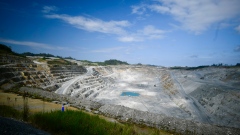Feb 8, 2024
Ukrainian Commander Who Defended Kyiv Early in War Takes Top Job
, Bloomberg News
(Bloomberg) -- Ukraine’s new army chief was key in defending Kyiv against all odds at the start of the Russian invasion. Closing in on the war’s two-year mark, Oleksandr Syrskyi now has the fate of the conflict in his hands.
Syrskyi, 58, was called on by President Volodymyr Zelenskiy to take over as his top general on Thursday in the biggest military shakeup since the start of the war. The commander of Ukraine’s ground forces, he succeeds Valeriy Zaluzhnyi, who was replaced following weeks of speculation about his deepening rift with the president.
Unlike Zaluzhnyi, Syrskyi lacks a broad public profile in Ukraine. Zelenskiy referred to him as Ukraine’s “most experienced” commander, citing his deep involvement in defending the capital during the first phase of the Russian onslaught and the liberation of a swathe of the Kharkiv region later in 2022.
Oleksiy Melnyk, a co-director of the Kyiv-based Razumkov Center, said the change won’t have a major impact on the course of the conflict, but will end a period of uncertainty as speculation was rife about the tension between the president and Zaluzhniy.
“It undermined the morale of the Armed Forces and public sentiment,” Melnyk said. “The longer it lasted, the worse the consequences would be.”
The president’s choice marks a contrast. A more dour presence than the outsize Zaluzhnyi, Syrskyi will have a challenge replacing a general known for his human touch with soldiers on the battlefield, regardless of rank.
‘Remains Tense’
Born in what was then Soviet Russia, Syrskyi graduated from a military academy in Moscow and speaks Ukrainian with a heavy Russian accent. The general, who gained combat experience in the eastern Donbas region fighting Russia-backed separatists after 2014, gained wide attention as he led a dramatic liberation of parts of the Kharkiv region, forcing the Russian military into a chaotic surrender.
More controversially, Syrskyi was responsible for the defense of Bakhmut, which Russia captured last year after months of siege that led to thousands of casualties on both sides. Syrskyi told the Economist in December that anyone who underestimates Russians “is headed for defeat.”
Syrskyi appeared recently with soldiers on the frontline near the northeastern city of Kupyansk, where Russian units have mounted an offensive. Amid fierce fighting, the general said the “operational situation remains tense,” in a Feb. 3 post on Telegram.
The president said in an address to the nation late Thursday that Syrskyi, who has reported to Zaluzhnyi, would present a team to “reset” the armed forces in the coming days. He said the change was “not about surnames. And certainly not about politics.”
But politics would loom large over the military shakeup, which Zelenskiy described as an attempt at a restart at a time when Ukraine is increasingly out-gunned by Russia’s war machine and running short of Western aid.
While Zelenskiy is getting a commander who can be relied on for loyalty, the reshuffle is also unlikely to be a quick fix for the challenges that Zaluzhnyi has faced.
The former army chief has been outspoken about a new law on conscription that aims to replenish the depleted ranks of the army, but is unpopular with the Ukrainian people. He criticized the pace of drafting new soldiers as too slow, while Zelenskiy has resisted the military’s request to mobilize as many as 500,000 additional troops.
While the president said Zaluzhnyi will remain “part of the team,” he said little about what the general’s role is going to be. But looming above all — and posing a political risk to Zelenskiy — is Zaluzhnyi’s universal popularity in Ukraine, generally registering at more than 90%.
“Syrskyi divided opinion like no other military figure in Ukraine,” said Phillips O’Brien, a professor of strategic studies at the University of St. Andrews. “His appointment is a risky move by Zelenskiy.”
--With assistance from Olesia Safronova and Daryna Krasnolutska.
©2024 Bloomberg L.P.








